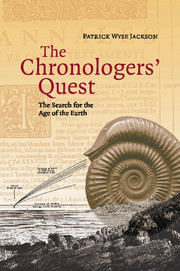Book contents
- Frontmatter
- Contents
- List of illustrations
- List of tables
- Preface
- Acknowledgements
- 1 The ancients: early chronologies
- 2 Biblical calculations
- 3 Models of Aristotelian infinity and sacred theories of the Earth
- 4 Falling stones, salty oceans, and evaporating waters: early empirical measurements of the age of the Earth
- 5 Thinking in layers: early ideas in stratigraphy
- 6 An infinite and cyclical Earth and religious orthodoxy
- 7 The cooling Earth
- 8 Stratigraphical laws, uniformitarianism and the development of the geological column
- 9 ‘Formed stones’ and their subsequent role in biostratigraphy and evolutionary theory
- 10 The hour-glass of accumulated or denuded sediments
- 11 Thermodynamics and the cooling Earth revisited
- 12 Oceanic salination reconsidered
- 13 Radioactivity: invisible geochronometers
- 14 The Universal problem and Duck Soup
- Bibliography
- Index
13 - Radioactivity: invisible geochronometers
Published online by Cambridge University Press: 02 December 2009
- Frontmatter
- Contents
- List of illustrations
- List of tables
- Preface
- Acknowledgements
- 1 The ancients: early chronologies
- 2 Biblical calculations
- 3 Models of Aristotelian infinity and sacred theories of the Earth
- 4 Falling stones, salty oceans, and evaporating waters: early empirical measurements of the age of the Earth
- 5 Thinking in layers: early ideas in stratigraphy
- 6 An infinite and cyclical Earth and religious orthodoxy
- 7 The cooling Earth
- 8 Stratigraphical laws, uniformitarianism and the development of the geological column
- 9 ‘Formed stones’ and their subsequent role in biostratigraphy and evolutionary theory
- 10 The hour-glass of accumulated or denuded sediments
- 11 Thermodynamics and the cooling Earth revisited
- 12 Oceanic salination reconsidered
- 13 Radioactivity: invisible geochronometers
- 14 The Universal problem and Duck Soup
- Bibliography
- Index
Summary
INVISIBLE RAYS
While most people can name the inventor of the television – the Scottish scientist John Logie Baird (1888–1946) – few of us can remember who invented the cathode ray tube, a fundamental part of the television without which it just would not work. For the first cathode ray tube, we can thank Sir William Crookes (1832–1919), an affluent chemist who had established his own private laboratory in London. The kind now used in televisions is a variant designed by Karl Ferdinand Braun (1850–1918), the German physicist whose name is now on many domestic electrical appliances. While working with a Crookes Tube in his laboratory at the University of Würzburg in Germany in 1895, the physicist Wilhelm Röntgen (1845–1923) made a remarkable discovery. When he turned the cathode tube on he discovered that barium platinocyanide sitting on a shelf on the other side of the room started to glow slightly. He then removed the chemical to the next room, and it still glowed. The explanation suddenly occurred to him: while the tube was producing cathode rays it was also producing another invisible ray that had the ability to pass through thin sheets of metal, which the cathode rays could not penetrate. As he had no clue what the rays were or what formed them he simply called them ‘X-rays’. He then experimented with their properties and produced an image of his wife's hand by placing it on a photographic plate and exposing it to the X-rays.
- Type
- Chapter
- Information
- The Chronologers' QuestThe Search for the Age of the Earth, pp. 227 - 249Publisher: Cambridge University PressPrint publication year: 2006



